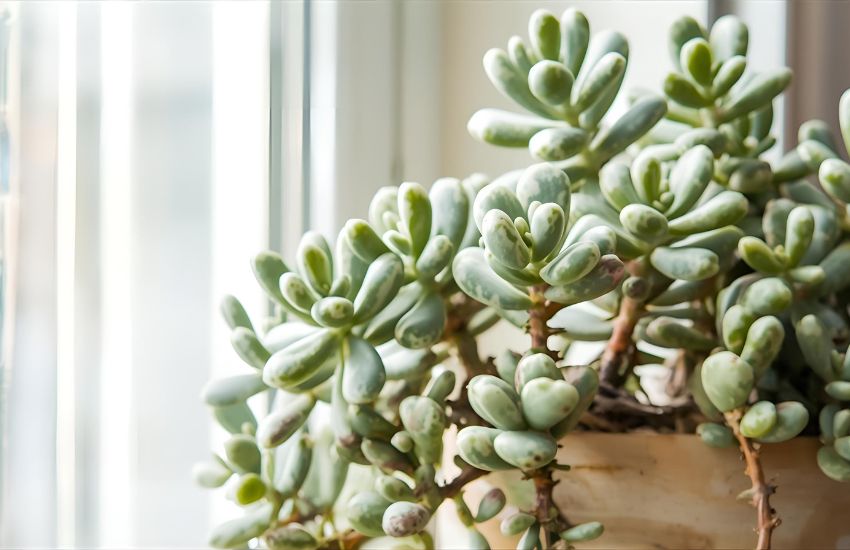A variegated jade plant captures attention with its creamy-white and green foliage that sets it apart from ordinary succulents. This striking shrub, belonging to the Crassulaceae family, has its origins in South Africa and thrives when treated with the right balance of soil, water, and sunlight. As a low-maintenance houseplant, it is well suited for indoor spaces, yet its beauty can rival even the most ornamental garden plants.
Crassula Ovata Variegated, or variegated jade plant, thrives indoors with bright, indirect light and minimal watering. Allow the soil to dry between waterings to prevent root rot. Use well-draining soil and a sturdy pot for healthy growth. With proper care, this slow-growing succulent rewards you with stunning foliage, adding charm and elegance to your indoor space.
In this care guide, you will explore practical tips on watering schedules, soil selection, light preferences, and pruning methods. You will also discover how to protect your indoor cactus-like plant from common problems while ensuring it produces those small, star-shaped blooms. With the right approach, your variegated jade plant will flourish into a long-lasting companion for your home.
Crassula Ovata Variegated: How to Care for This Unique Jade Plant Cultivar

The Crassula ovata variegated, often known as the tricolor jade or variegata, is a highly attractive cultivar admired for its creamy, pink, and green leaves. This easy grower is part of the evergreen Crassula family and is recognized for its fleshy, tubular leaves that form compact clusters at the ends of the branches. A mature specimen can even produce delicate white or pink flowers in the winter, adding seasonal charm to your collection. Some varieties, such as Hummel’s Sunset and Gollum (commonly called “ET’s Fingers”), have also gained the Royal Horticultural Society’s Award of Garden Merit for their ornamental appeal.
Light and Temperature Requirements
Your jade plant requires bright light for healthy growth. Position it near a sunny window where it can receive several hours of direct sunlight, or supplement with a grow light in low-light indoor conditions. While tolerant of various climates, it cannot withstand frost or freezing temperatures, so keeping it inside during colder months is essential. In suitable USDA hardiness zones, it thrives outdoors as well.
Soil and Watering
The right potting soil is crucial to protect your tricolor jade from root rot. Choose a gritty mix with perlite for aeration, ensuring the medium remains well-draining and well-drained after each watering. Overwatering is the most common sign of disease in this plant, so allow the soil to dry before giving it more water. Balanced humidity also plays a role, though this succulent tolerates drier air much better than excess moisture.
Growth and Propagation
As this cultivar matures, its branches develop woody textures, enhancing its appeal as both a houseplant and landscape specimen. The leaves are thick and glossy, displaying a tricolor effect of green leaves streaked with cream and pink margins. Propagation is simple through branch or leaf cuttings, making it easy to expand your collection. A properly cared-for plant can reach a diameter of up to 2.5 feet, showcasing strong, compact growth.
Feeding and Seasonal Blooms
To encourage healthy development, apply a balanced fertilizer during the growing season. With patience and optimal conditions, you may be rewarded with small starry clusters of white flowers that appear as flowers in winter. These blossoms form at the ends of the branches, further elevating the ornamental value of this cultivar.
Conclusion
Caring for your Crassula Ovata Variegated successfully requires attention to several key factors. Ensuring your plant receives enough light and bright sunlight will support healthy growth, while maintaining well-draining soil prevents root rot and keeps the root system strong. Allow the soil to be left to dry between waterings, and monitor temperature and humidity to avoid stress from environmental factors or hard frost. As a beginner, you will appreciate how resilient this succulent can be, whether grown indoors or outdoors.
Varieties like Finger Jade, Monstrose, or even Money Tree companions can thrive alongside your tricolor jade when given proper care. Regular checks for pests and careful handling of water-transferring pores called callus will preserve its fleshy leaves and enhance flowering. With patience and dedication, you can enjoy stunning star-shaped flowers that appear seasonally and the elegant, tubular leaves that make this plant a true standout.
Start cultivating your variegated jade today and transform your indoor space into a vibrant succulent haven—your thriving Finger Jade awaits!
Frequently Asked Questions (Crassula Ovata Variegated Care Guide: Grow a Stunning Variegated Jade Plant Indoors)
How to care for a variegated jade plant indoors?
To care for a variegated jade plant indoors, place it in bright, indirect sunlight near a south-facing window. Use well-draining soil and water only when the topsoil is dry, avoiding overwatering. Maintain room temperatures between 18–24°C and low humidity. Fertilize monthly during spring and summer. Prune gently to encourage bushy growth.
Does Crassula ovata need direct sunlight?
Yes, Crassula ovata (jade plant) thrives in bright, indirect light but also benefits from some direct sunlight. Ideally, place it near a south- or west-facing window where it can get at least 4–6 hours of sun daily. Too little light causes leggy growth, while too much intense sun may scorch its leaves.
How often should I water jade Crassula?
Water your jade Crassula sparingly, as it is a succulent that stores water in its leaves. Generally, water every 2 to 3 weeks, allowing the soil to dry out completely between waterings. In summer, it may need more frequent watering, while in winter, reduce watering to once a month to prevent root rot.
Can you grow Crassula ovata indoors?
Yes, you can grow Crassula ovata (jade plant) indoors successfully. It thrives in bright, indirect light near a sunny window, preferably south or west-facing. Use well-draining soil and water only when the topsoil feels dry to prevent root rot. Maintain moderate room temperatures, avoid overwatering, and occasionally prune for shape and healthy growth indoors.
